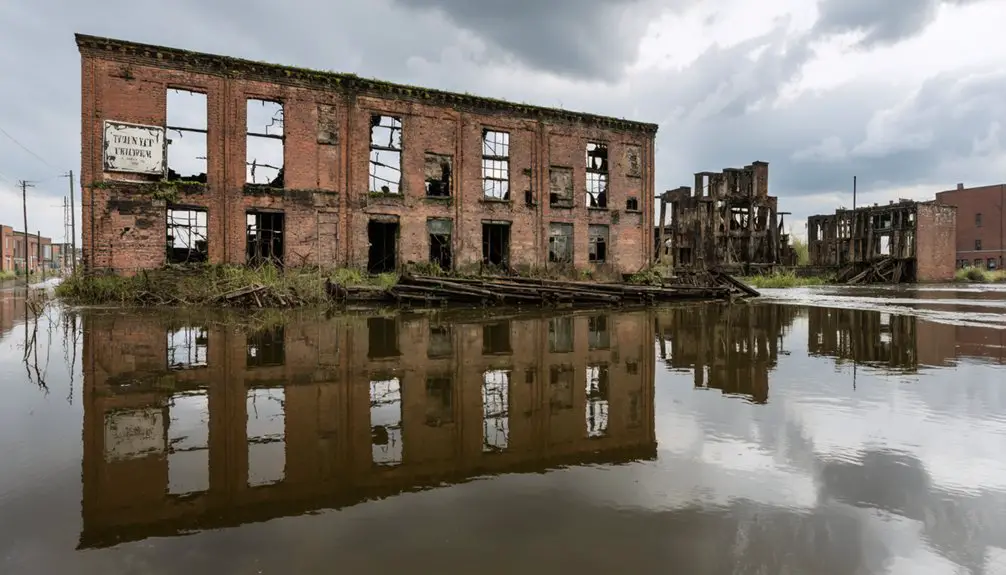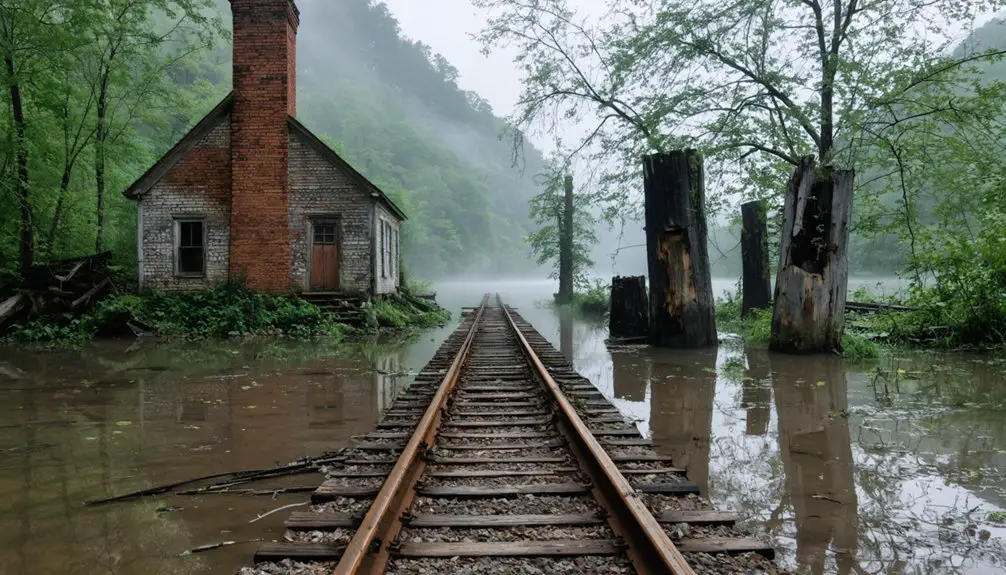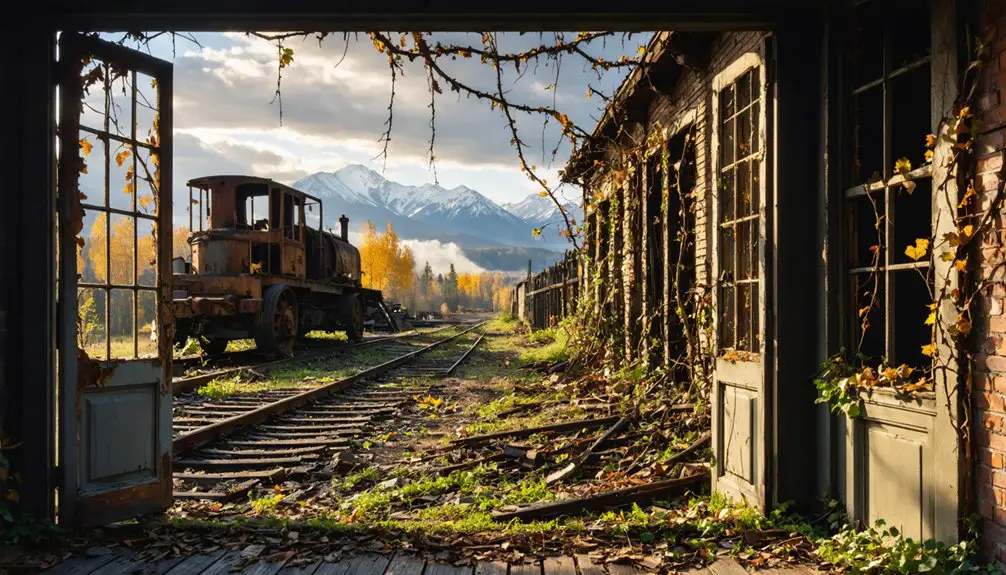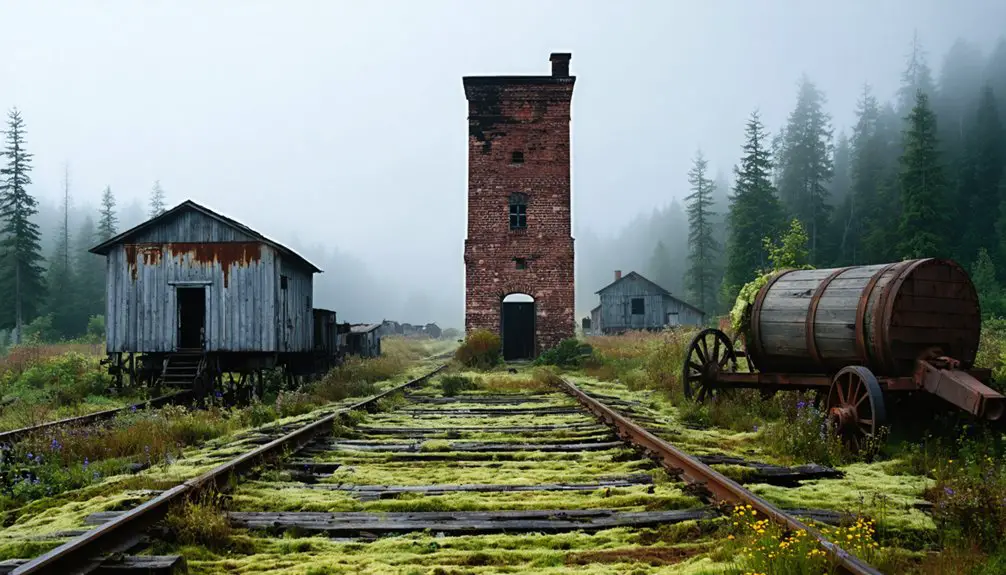You’ll find Cokeville’s story in western Pennsylvania’s coal country, where it emerged as an essential coke-processing hub in the early 1800s. The town thrived through the industrial revolution, with beehive ovens transforming soft coal into high-grade coke for America’s steel industry. But persistent flooding along the Conemaugh River led to its demise, and by the 1950s, the construction of Conemaugh Dam forced the evacuation of 122 structures. The remnants of this once-bustling community hold fascinating tales of industrial innovation and environmental challenge.
Key Takeaways
- Cokeville was a thriving industrial town in Pennsylvania centered around beehive coke ovens and coal processing during the 1800s-1900s.
- The town supported half of America’s coke production by 1913, with 38,000 ovens operating in the Connellsville district.
- Persistent flooding threats and the devastating St. Patrick’s Day flood of 1936 led to major flood control measures.
- The construction of Conemaugh Dam in the 1950s required the removal of 122 structures, leading to Cokeville’s complete abandonment.
- The former town site is now submerged and integrated into the Conemaugh Dam’s flood control system.
The Birth of a Coal Mining Community
As the industrial revolution swept through Pennsylvania in the early 1800s, Cokeville emerged from the pioneering experiments in coal and coke production near Fayette County.
You’ll find its roots in the early attempts of innovators like Isaac Meason and the Englishman Nichols, who tested local coal seams in stone beehive ovens until achieving success with the Plummer Mine coal in 1833.
The community development accelerated when Henry Clay Frick established his coke plant in 1870, transforming the region into a bustling industrial hub. The region’s beehive ovens were so productive that they supplied half of America’s coke by 1913.
You’ll discover how the coal companies built complete villages, attracting a diverse immigrant workforce from Europe and African-American laborers.
These company towns provided everything from dual housing units to schools, churches, and stores – creating a self-contained world where miners’ lives revolved around the rhythms of coal extraction. By the 1920s, nearly half of Pennsylvania’s miners lived in these company-owned communities, relying entirely on their employers for basic necessities.
Life in the Bustling Industrial Town
While smoke billowed from countless beehive ovens, daily life in Cokeville revolved around the strict rhythms of industrial work schedules.
You’d find miners and coke workers living in modest company houses near the industrial sites, creating tight-knit neighborhoods where families shared their industrial heritage across generations.
The Western Pennsylvania Railroad kept you connected to nearby towns, while local shops and eateries met your daily needs. The Isabella Furnace Company established 200 coke ovens that drove the town’s economic growth.
You’d gather with neighbors at church events and community gatherings, finding solace from the harsh working conditions.
The Conemaugh River and nearby canal system served both industry and recreation, though coal dust and industrial byproducts were constant companions. Local beavers inhabited the canal waters, adapting to the industrial landscape.
Despite environmental challenges, you’d supplement your income through fishing, hunting, and small trades, all while building strong social bonds within your workplace and neighborhood communities.
The Role of Coke Production
You’ll find the remnants of Cokeville’s massive beehive coke ovens along the Conemaugh River, where workers once transformed the region’s soft coal into high-grade coke for the steel industry.
The town’s strategic location made it a crucial coal processing hub, with its ovens producing essential fuel for blast furnaces throughout western Pennsylvania. During peak production, the nearby coal beds yielded five feet thick coking coal with minimal impurities.
The beehive-style ovens required workers to roast the soft coal for one to two days while carefully controlling air exposure to create quality coke.
Coke Ovens and Operations
During the late 19th century, coke production emerged as a cornerstone of Pennsylvania’s industrial might, transforming from scattered operations of dozen-oven sites before 1870 into massive commercial enterprises.
You’ll find that Uniondale marked this shift in 1869, launching with 40 ovens that showcased the region’s changeover to large-scale operations.
The distinctive beehive-shaped ovens you’d see at these sites weren’t just industrial architecture – they were essential to transforming high-quality Pennsylvania coal into the carbon-rich fuel that powered America’s steel industry. These operations continued until beehive ovens ceased in 1972, marking the end of an era in American industrial history.
By 1913, the Connellsville district alone operated 38,000 ovens, requiring 2,000 railcars daily to transport their output.
These operations supplied half of the nation’s metallurgical coke, stretching their market reach from Chicago to the Mississippi River.
Regional Coal Processing Hub
As Pennsylvania’s Connellsville Coalfield emerged in the mid-19th century, this rich deposit spanning Fayette and Westmoreland Counties transformed into America’s premier coal processing hub.
You’ll find the region’s success rooted in its exceptional Pittsburgh seam, which yielded high-quality metallurgical coal perfect for coke production. The area’s industrial might skyrocketed after the Civil War, with dozens of coal towns springing up to support the booming operations. Under the leadership of H.C. Frick Coal and Coke, the region dominated the industry as a subsidiary of U.S. Steel. The development of Connellsville coke in 1841 marked a pivotal shift in the region’s industrial future.
- Annual coal consumption exceeded 28 million tons during peak years
- Over 60 coal towns supported the workforce and processing logistics
- Coal seams reached depths of 500 feet with thickness up to 9 feet
- Each beehive oven used 3,650 total bricks for construction
- A single oven charge processed 100 bushels of coal every 72 hours
Industrial Equipment and Technology
Pioneering the industrial landscape of Pennsylvania’s coal region, beehive coke ovens revolutionized the processing of coal into valuable metallurgical coke from the late 1800s through the early 1900s.
You’d find these distinctive dome-shaped ovens holding up to 160 bushels of coal each, where the raw material would roast for up to two days before being cooled with water.
At sites like Adrian, you’d see massive batteries of ovens – 550 in total by 1887 – supported by coke crushers that guaranteed uniform product size.
Steam machinery powered the operations, while tipples and railways managed the movement of materials.
This industrial symphony transformed raw coal into high-carbon fuel that would feed the region’s hungry blast furnaces, driving Pennsylvania’s iron and steel industry forward. To avoid confusion with other industrial sites, clear article navigation helped workers and visitors locate specific coke production facilities.
Environmental Challenges and Flood Concerns

You’ll find that Cokeville’s fate was sealed by the devastating St. Patrick’s Day flood of 1936, which prompted the U.S. Army Corps of Engineers to implement major flood control measures.
The construction of the Conemaugh Dam in response to this disaster led to the complete abandonment of Cokeville by the early 1950s, with 122 structures removed from the floodplain.
Today, the former town site serves as part of the dam’s flood control system, with restricted development and natural vegetation reclaiming the area to help manage future flood risks.
Recurring Flood Hazards
While the Conemaugh River valley offered settlers strategic advantages, its narrow topography made Cokeville particularly vulnerable to devastating floods.
You’ll find that flood frequency in this region wasn’t just a rare occurrence – it was a persistent threat that shaped the town’s destiny. The combination of frozen ground, heavy rainfall, and rapid snowmelt created dangerous conditions that local water management couldn’t fully control.
- Floodwaters could rise swiftly, reaching over 30,000 cubic feet per second
- Winter soil freezing up to 4 feet deep prevented ground absorption
- The St. Patrick’s Day flood of 1936 followed 50 hours of continuous rain
- Seasonal snowmelt combined with rainfall created compound flooding hazards
- Evacuations often required boats due to rapidly rising waters and cut-off roads
These recurring floods eventually contributed to Cokeville’s abandonment, as residents faced the harsh reality of nature’s unstoppable force.
Dam Construction Impact
In response to the persistent flooding challenges, the South Fork Reservoir project marked a significant engineering intervention in Cokeville’s landscape during the 1830s. State engineers identified South Fork Creek as the prime location for controlling water flow and supporting canal operations across Allegheny Mountain.
You’ll find that the dam’s impact on Cokeville’s dam history reached its peak in the early 1950s when the Conemaugh Dam project forever altered the region. The flooding of 122 structures transformed your once-vibrant community into an inundated floodplain.
Despite the forced relocation testing community resilience, the project achieved its intended flood control purposes. Today, the reservoir stands as a symbol of environmental transformation, having converted dynamic river ecosystems into managed waterways while displacing wildlife and altering aquatic habitats.
Natural Disaster Prevention
Due to its precarious location on the Conemaugh River floodplain, Cokeville faced persistent environmental challenges that shaped its eventual fate. The town’s flood management and disaster preparedness efforts couldn’t overcome the harsh realities of its low-lying terrain and poor natural drainage.
- Seasonal snowmelt and spring rains regularly threatened the community
- Industrial activities upstream increased the risk of flash flooding
- Poor drainage conditions kept flood waters lingering longer
- Groundwater fluctuations compromised soil stability
- Lack of early flood control infrastructure left residents vulnerable
You’ll find that nature has now reclaimed much of Cokeville’s former territory. Wildlife thrives where homes once stood, though environmental challenges persist.
The area’s floodplain continues its natural cycles, with sediment buildup and seasonal water fluctuations shaping the landscape where a community once fought to survive.
The Conemaugh Dam Project’s Impact

Authorized by the Flood Control Act of 1936, the Conemaugh Dam project fundamentally transformed the landscape and communities of western Pennsylvania.
When construction began in 1949, you’d have witnessed the U.S. Army Corps of Engineers undertaking one of the region’s most ambitious flood control initiatives. The 850-foot concrete gravity dam required significant community displacement, including the town of Cokeville.
While the project forced residents to relocate, it’s prevented over $2.2 billion in flood damages since its 1952 completion.
Today, you’ll find Conemaugh Lake where communities once stood, serving both as critical infrastructure and a recreational destination. The dam’s 14 MW hydroelectric station, added in 1989, continues to provide renewable energy, while the reservoir protects downstream communities from the devastating floods that once plagued the region.
Evacuation and Relocation Stories
When toxic gases and dangerous ground conditions threatened Centralia’s residents in the early 1980s, the U.S. government stepped in with a $42 million buyout program.
You’d witness families facing tough evacuation experiences as they chose between staying in their cherished homes or accepting relocation for safety. The underground fire‘s deadly gases and sudden sinkholes made the choice clear for most residents.
- A 150-foot sinkhole swallowed a child in 1981
- Carbon monoxide levels became lethal in homes
- Ground temperatures rose to dangerous levels
- Infrastructure started failing throughout town
- Families dispersed to nearby communities
What Remains Today: A Ghost Town’s Legacy

Today, little remains of what was once the bustling community of Cokeville except scattered building foundations and deteriorating infrastructure near Tornence, Pennsylvania.
If you’re interested in ghost town exploration, you’ll find abandoned bridges and roadways marking the town’s former footprint, though nature has steadily reclaimed the landscape.
The site now serves as a reflection of Pennsylvania’s industrial heritage, with the land reverting to pasture and woodland.
While some historical artifacts and photographs document Cokeville’s past, physical preservation is minimal.
You can still spot remnants of the coal industry’s influence through abandoned structures and altered landscapes.
The area draws occasional visits from historians and enthusiasts, though access may be restricted as much of the land falls under private ownership or environmental protection regulations.
Preserving Cokeville’s History
While physical remnants of Cokeville continue to fade, dedicated preservation efforts have captured the town’s history through multiple channels.
Though Cokeville’s structures may crumble, committed historians and archivists ensure its stories and memories endure through time.
You’ll find extensive documentation in archival photographs, including a thorough 1952 town tour that recorded Cokeville’s layout before its abandonment. Community events and oral histories keep the town’s memory alive through the stories of former residents and their descendants.
- Historical societies maintain detailed records of Cokeville’s origins as Broad Fording
- Local tours and YouTube documentaries share the town’s story with new generations
- Former residents contribute personal narratives about life before the flood control project
- Archival photographs and videos document the town’s final days
- Online resources classify and preserve Cokeville’s status among Pennsylvania ghost towns
Frequently Asked Questions
What Happened to the Residents Who Refused to Leave Cokeville?
If you’re wondering about defiant Cokeville residents, they couldn’t stay – government mandates forced everyone out by 1952. Historical records don’t show any holdouts surviving at the original site after demolition.
Were Any Historical Artifacts Preserved From Cokeville Before Its Abandonment?
You’ll find virtually no physical Cokeville artifacts survived, as buildings were removed before flooding. Only photographs from 1952, oral histories, and some bridge abutments remain for historical preservation today.
Did Any Businesses From Cokeville Successfully Relocate and Continue Operating?
While records are limited, you’ll find that some surviving enterprises successfully relocated, including a general store, gas station, and tavern that moved to Homer City and continued their business operations.
What Was the Average Property Compensation Given to Displaced Cokeville Residents?
You won’t find specific average property values or compensation figures for displaced Cokeville residents, as historical records don’t document the exact amounts paid during the flood control project’s buyout program.
Are There Any Annual Reunions or Gatherings of Former Cokeville Residents?
You won’t find documented annual reunions of former Cokeville residents. Though community connections were important to Cokeville history, the 1950s displacement scattered families, making organized gatherings unlikely to occur.
References
- https://www.youtube.com/watch?v=eXuTEdK79dY
- https://en.wikipedia.org/wiki/List_of_ghost_towns_in_Pennsylvania
- https://triblive.com/local/westmoreland/cokeville-memories-former-residents-hikers-revisit-ghost-of-derry-township-village/
- http://coalandcoke.blogspot.com/2013/11/cokeville-paisabella-furnace-mine-and.html
- https://en.wikipedia.org/wiki/Cokeville
- https://newsinteractive.post-gazette.com/coal-towns/
- https://gaptrail.org/amenities/connellsville-coke-ovens/
- https://www.iup.edu/library/departments/archives/coal/coal-culture-timeline.html
- https://fayettehistoricalsociety.org/history/hid6.html
- http://amrclearinghouse.org/Sub/SCARLIFTReports/Redstone/Chapter 3.pdf



